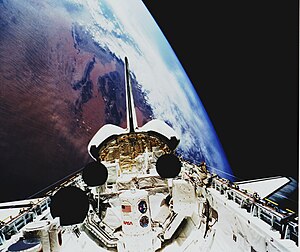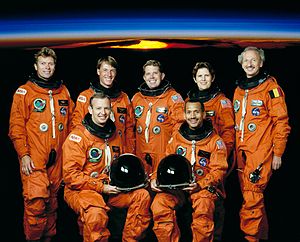
Summary
STS-45 was a 1992 NASA Space Shuttle mission using the Space Shuttle Atlantis. Its almost nine-day scientific mission was with a non-deployable payload of instruments. It was the 46th Space Shuttle mission and the 11th for Atlantis.
 Components of the ATLAS-1 laboratory in the payload bay of Atlantis | |
| Names | Space Transportation System-45 |
|---|---|
| Mission type | Astronomy research |
| Operator | NASA |
| COSPAR ID | 1992-015A |
| SATCAT no. | 21915 |
| Mission duration | 8 days, 22 hours, 9 minutes, 28 seconds |
| Distance travelled | 5,211,340 km (3,238,180 mi) |
| Orbits completed | 143 |
| Spacecraft properties | |
| Spacecraft | Space Shuttle Atlantis |
| Launch mass | 105,982 kg (233,650 lb) |
| Landing mass | 93,009 kg (205,050 lb) |
| Payload mass | 9,947 kg (21,929 lb) |
| Crew | |
| Crew size | 7 |
| Members | |
| Start of mission | |
| Launch date | March 24, 1992, 13:13:39 UTC |
| Rocket | Space Shuttle Atlantis |
| Launch site | Kennedy Space Center, LC-39A |
| Contractor | Rockwell International |
| End of mission | |
| Landing date | April 2, 1992, 11:23 UTC |
| Landing site | Kennedy Space Center, SLF Runway 33 |
| Orbital parameters | |
| Reference system | Geocentric orbit |
| Regime | Low Earth orbit |
| Perigee altitude | 282 km (175 mi) |
| Apogee altitude | 294 km (183 mi) |
| Inclination | 57.00° |
| Period | 90.30 minutes |
| Instruments | |
| |
 STS-45 mission patch  Standing: Byron K. Lichtenberg, Michael Foale, David Leestma, Kathryn D. Sullivan, Dirk Frimout Seated: Brian Duffy, Charles Bolden | |
Crew edit
| Position | Astronaut | |
|---|---|---|
| Commander | Charles Bolden Third spaceflight | |
| Pilot | Brian Duffy First spaceflight | |
| Mission Specialist 1 | Kathryn D. Sullivan Third and last spaceflight | |
| Mission Specialist 2 | David Leestma Third and last spaceflight | |
| Mission Specialist 3 | Michael Foale First spaceflight | |
| Payload Specialist 1 | Dirk Frimout , ESA Only spaceflight | |
| Payload Specialist 2 | Byron K. Lichtenberg Second and last spaceflight | |
Backup crew edit
| Position | Astronaut | |
|---|---|---|
| Payload Specialist 1 | Michael L. Lampton First spaceflight | |
| Payload Specialist 2 | Charles R. Chappell First spaceflight | |
Crew seating arrangements edit
| Seat[1] | Launch | Landing | Seats 1–4 are on the Flight Deck. Seats 5–7 are on the Middeck. |
|---|---|---|---|
| S1 | Bolden | Bolden | |
| S2 | Duffy | Duffy | |
| S3 | Sullivan | Foale | |
| S4 | Leestma | Leestma | |
| S5 | Foale | Sullivan | |
| S6 | Frimout | Frimout | |
| S7 | Lichtenberg | Lichtenberg |
Mission highlights edit
Atlantis was launched on March 24, 1992, at 8:13 a.m. EST. The launch was originally scheduled for March 23, 1992, but was delayed by one day because of higher-than-allowable concentrations of liquid hydrogen and liquid oxygen in the orbiter's aft compartment during tanking operations. During troubleshooting, the leaks could not be reproduced, leading engineers to believe that they were the result of plumbing in the main propulsion system not thermally conditioned to the cryogenic propellants; the launch was rescheduled for March 24, 1992. Atlantis weighed 105,982 kg (233,650 lb) at launch.
STS-45 carried the first Atmospheric Laboratory for Applications and Science (ATLAS-1) experiments, placed on Spacelab pallets mounted in the orbiter's payload bay. The non-deployable payload, equipped with 12 instruments from the United States, France, Germany, Belgium, Switzerland, the Netherlands and Japan, conducted studies in atmospheric chemistry, solar radiation, space plasma physics and ultraviolet astronomy. ATLAS-1 instruments included the Atmospheric Trace Molecule Spectroscopy (ATMOS); Grille Spectrometer; Millimeter Wave Atmospheric Sounder (MAS); Imaging Spectrometric Observatory (ISO); Atmospheric Lyman-Alpha Emissions (ALAE); Atmospheric Emissions Photometric Imager (AEPI); Space Experiments with Particle Accelerators (SEPAC); Active Cavity Radiometer (ACR); Measurement of Solar Constant (SOLCON); Solar Spectrum;[2] Solar Ultraviolet Spectral Irradiance Monitor (SUSIM); and Far Ultraviolet Space Telescope (FAUST). Other payloads included the Shuttle Solar Backscatter Ultraviolet (SSBUV) experiment, a Get Away Special (GAS) experiment and six mid-deck experiments.
The mission was extended by a day in order to continue science experiments. The landing occurred on April 2, 1992, 6:23 a.m. EST, on Runway 33 of the Shuttle Landing Facility, located at the Kennedy Space Center. The rollout distance was 2,812 m (9,226 ft) and Atlantis weighed 93,005 kg (205,041 lb) on landing.
Mission insignia edit
The mission insignia covers all aspects of the flight, by featuring Earth and the Sun, and the orbiter on high inclination, as to illustrate the high importance of the mission. The names of all flying members are included in the band, separated by stars. In the 'ring' at the bottom right, a single star is included, separating the unmentioned names of the alternate mission specialists, who are therefore indirectly included; a first and unique tribute to a support crew. Dirk Frimout is the first Belgian citizen to fly into space, and the only one to fly on a Space Shuttle (the other is Frank De Winne (who flies to the International Space Station via Soyuz as mission commander), as the Space Shuttle program was terminated at the time of the latter's flight), but to keep the focus on the mission, no national flag is added nor the customary logo of the European Space Agency (ESA), but the mission main objective, ATLAS, is included below instead.
See also edit
References edit
External links edit
- STS-45 Video Highlights Archived October 18, 2013, at the Wayback Machine
- NASA mission summary Archived November 30, 2013, at the Wayback Machine
- STS-45 Amateur Radio Contact with Harrogate Ladies' College in 1992.


